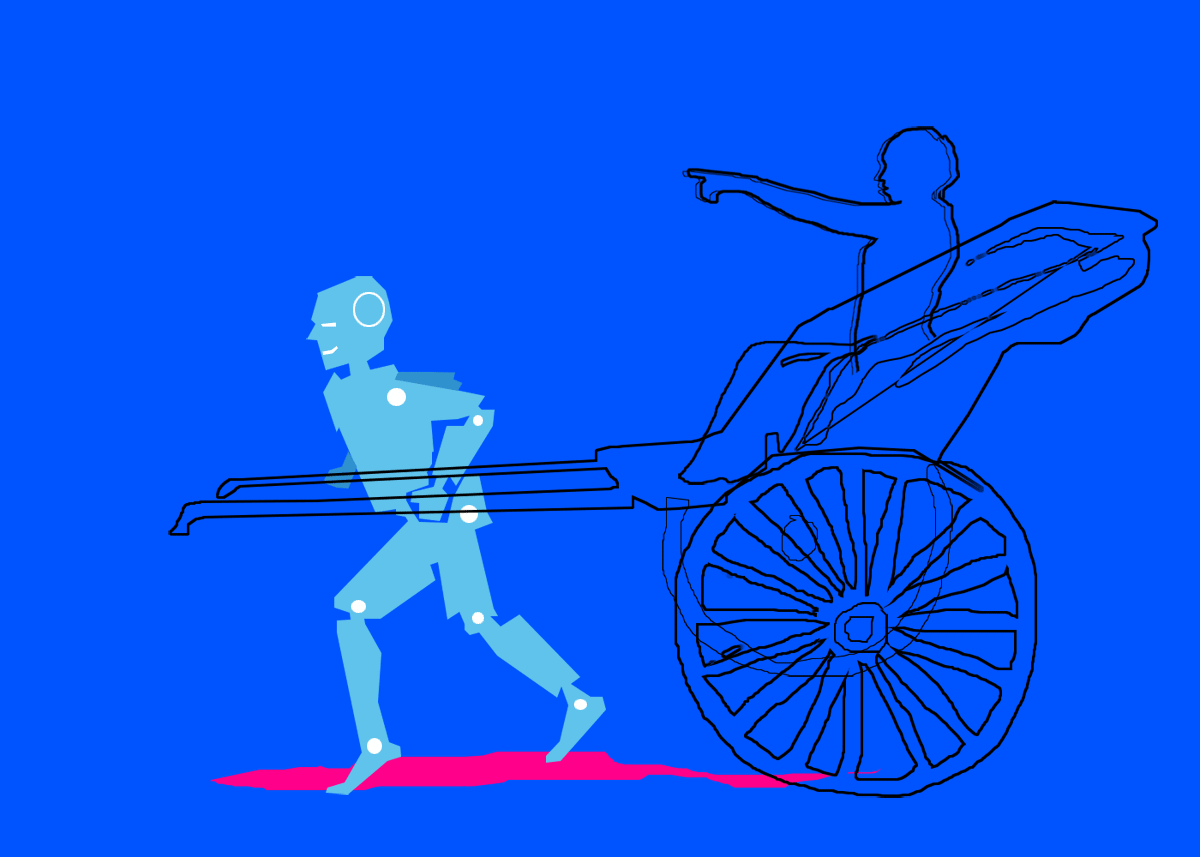 | « Back to article | Print this article |
When AI is used to enhance operational efficiency, businesses can deliver the same product or service but with improved quality, faster, or even at a reduced cost.
A fascinating excerpt from Aswin Chandarr's book, The Inevitable AI: Art Of Growth With Generative Intelligence.

Visualize this: It's a brisk Monday morning in the executive suite. The aroma of freshly brewed coffee wafts through the air as a team leader or a CEO, invigorated by a recent AI podcast, declares with contagious enthusiasm, "It's high time we harness the power of AI!
"The future is knocking at our door, and we must answer with innovation!"
The response is often a room full of bemused faces and the unspoken question, "So, where do we start?" They've heard this kind of enthusiasm before, but understanding how to translate it into actionable plans remains elusive.
Remember, embracing AI isn't about jumping onto a trend bandwagon. It's about aligning AI with your enterprise's vision, values, and goals.
Adapting to AI is like learning to dance with a new partner-- one whose steps are powered by algorithms and predictive analysis. Balancing your human workforce's strengths with AI's efficiency is a delicate tango.
The Sword of Disruption
The word 'disruption' is often tied to worker job security in the age of AI, but its ramifications stretch far beyond. As a potent force, it can destabilize even the most established businesses.
Let's dissect this further, starting with the first core aspect of "business value proposition."
Imagine being at the helm of a market-leading company, enjoying years of success and customer loyalty.
You're not just surviving; you're thriving. You've cornered a significant market share, and your name is synonymous with your industry. You're sitting pretty, right?
Yet, on the horizon, a storm is brewing. A fledgling startup, built from the ground up with AI woven into its DNA, is gaining momentum. Their value proposition is different. It's innovative. It's AI-driven.
In the world of AI, it's no longer just about who has been around the longest or who has the deepest pockets. Today, a fledgling startup, built from the ground up around AI -- an "AI Native" -- could threaten your position.
Such AI-native enterprises can offer superior products or services, personalized experiences, and unrivaled efficiency, all at competitive prices.
Consider the insurance sector. Traditional insurance companies have long thrived on offering standard insurance plans. But what if a new, AI-driven competitor enters the market, offering customized insurance plans tailored to each customer's needs, risks, and lifestyle?
Their value proposition is irresistible, and they could quickly seize a considerable market share.
Or, look at pharmaceutical companies. Drug discovery is a long and costly process. However, an AI-native firm has entered the scene, using machine learning to accelerate drug discovery and reduce costs dramatically.
Suddenly, they're producing effective medications faster and cheaper than established pharmaceutical giants.
In the legal domain, traditional firms may charge hefty fees for services that an AI-driven competitor can provide more swiftly and cost-effectively.
AI can analyze thousands of legal documents in a fraction of the time it would take a human, enabling these firms to offer quick and affordable legal services.
AI could lead to entirely new industries and services, just like the internet did with social media and e-commerce.
The key takeaway is that no industry is immune to AI's disruptive potential. Incumbents must stay vigilant, constantly reevaluating their value proposition in light of emerging AI capabilities.
They need to understand AI's potential in their industry, identify potential threats and opportunities, and be prepared to pivot or evolve their business model.
Ignoring AI's potential is no longer an option; it's a ticket to obsolescence. AI disruption is real and happening faster than most can anticipate.

The Internal Revolution
The second form of disruption resulting from AI isn't about novel, AI-driven competitors. Instead, it involves a transformation from within.
This second disruptive facet of AI lies in its potential to optimize internal business processes.
When AI is used to enhance operational efficiency, businesses can deliver the same product or service but with improved quality, faster, or even at a reduced cost.
This, too, can challenge the market status quo, leading to a shift in market share.
Take an insurance firm, for instance. It has hundreds of thousands of policy documents and client data.
Previously, a customer support agent would have to manually search through this massive data pool to address a customer query. This process could be time-consuming and prone to errors.
However, the company can drastically improve this process with AI. Agents can get precise, real-time information at their fingertips by implementing a semantic search system powered by AI.
This speeds up customer service and improves quality, enhancing customer satisfaction.
Imagine two manufacturing companies competing in the same market. They have a similar product lineup and have been neck-and-neck in market share for years.
However, one company invests in AI to optimize its production processes, Machine learning algorithms predict maintenance needs, minimize downtime, and maximize efficiency.
AI-driven analytics provide real-time insights into supply chain inefficiencies, allowing the company to reduce waste and improve sourcing.
The result? This company can now produce the same goods more quickly, at a lower cost, and potentially even with better quality.
It passes these savings and benefits onto consumers, giving it a competitive advantage. Over time, it starts to carve a larger market share pie.
These examples underline that AI disruption is not solely an external threat posed by new, AI-native startups.
It also stems from within an industry, as existing competitors leverage AI to optimize their operations, offer better customer experiences, and innovate faster.
To ignore this aspect of AI disruption is to risk being left behind in the race, unable to match the efficiency, quality, and innovation offered by AI-empowered competitors.
Understanding and embracing AI is not just about future-proofing your business -- it's about securing a competitive advantage today.
The Talent Magnet: AI as a Beacon of Attraction
The third key aspect of AI's influence on businesses lies in human resources.
In the AI era, jobs involving lower-level cognitive tasks will increasingly be performed by machines, a shift we've already started to witness.
This isn't necessarily a cause for alarm; it opens up opportunities for humans to engage in more complex, higher-value tasks.
The displacement effect of AI isn't a job eliminator but a job evolver.
Employees who can effectively use AI tools, understand their nuances, and leverage their strengths for complex problem-solving will become increasingly valuable.

Imagine an engineer or a data scientist choosing between two firms. One is a traditional company, still relying largely on manual processes and legacy systems.
The other is an AI-forward company investing in the latest AI tools, promoting a culture of continual learning, and pushing the boundaries of what's possible with AI.
The latter is likely a much more attractive proposition for talent eager to work on the cutting edge of their field.
As such, companies that embrace and utilize cutting-edge AI technologies can become talent magnets.
Being at the forefront of AI adoption sends a clear message to current and potential employees: The company is forward-thinking, innovative, and committed to empowering its workforce with the best tools available.
This can incentivize talented, capable employees to stay, nurturing their growth and encouraging them to reach new heights of productivity.
By automating routine tasks, AI allows employees to focus on more challenging, rewarding work, leading to higher job satisfaction.
Employees can spend their time on creative problem-solving, strategic thinking, and innovation, all of which contribute to a more engaging and fulfilling work environment, resulting in a win-win for both sides.
In attracting and retaining talent, it's crucial to note that investing in AI is not just about purchasing and deploying the latest AI tools.
It's also about investing in the training and development of employees, enabling them to harness these tools effectively.
This commitment to employee growth further enhances a company's appeal to prospective employees and helps retain existing talent.
Your employees are your most valuable asset, and AI can empower them to perform at their best.
Excerpted from The Inevitable AI: Art Of Growth With Generative Intelligence by Aswin Chandarr, with the permission of the publishers, Stardom Books.
Feature Presentation: Ashish Narsale/Rediff.com